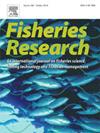Reducing codend mesh size and changing configurations to improve selectivity in Australian whiting (Sillago spp.) trawls
IF 2.2
2区 农林科学
Q2 FISHERIES
引用次数: 0
Abstract
In response to individual transferable quotas (ITQ) being implemented for whiting (Sillago flindersi and S. robusta) off New South Wales (NSW), Australia, two experiments were done to investigate if fish-trawl target inefficiencies and absolute bycatches could be reduced by replacing the legislated codend (handicapped by a minimum legal stretched mesh opening—SMO twice the optimum) with smaller-meshed designs. In experiment 1, compared to a conventional codend comprising 95 mm SMO (with a stretched circumference of ∼20 m, but restricted to 3.4 m by a rope), an unrestricted codend made from 46 mm SMO at an appropriate circumference (∼11 m stretched) and surrounded by a 94-mm SMO lifting bag caught ∼3–8 × more whiting h–1 trawled. Total bycatch weight h–1 trawled also increased, but only by ∼2 × and so, in terms of absolute amounts, fishing the smaller-meshed codend could evoke at least a 37 % reduction in discarded bycatch (or ∼1800 t) and ∼5500 h less trawling to harvest an average of ∼425 t of whiting quota each year by fish trawlers in NSW. In experiment 2, replacing 40 % of the 46-mm codend with a cylinder of smaller 41 mm SMO turned 90° (‘T90’) and with the same lifting bag further improved efficiency for whiting, but not size selectivity, and without affecting bycatch. The results illustrate the need to consider concomitant fishing-gear modifications in fisheries transferring to ITQ management to minimise unwanted environmental impacts.
求助全文
约1分钟内获得全文
求助全文
来源期刊

Fisheries Research
农林科学-渔业
CiteScore
4.50
自引率
16.70%
发文量
294
审稿时长
15 weeks
期刊介绍:
This journal provides an international forum for the publication of papers in the areas of fisheries science, fishing technology, fisheries management and relevant socio-economics. The scope covers fisheries in salt, brackish and freshwater systems, and all aspects of associated ecology, environmental aspects of fisheries, and economics. Both theoretical and practical papers are acceptable, including laboratory and field experimental studies relevant to fisheries. Papers on the conservation of exploitable living resources are welcome. Review and Viewpoint articles are also published. As the specified areas inevitably impinge on and interrelate with each other, the approach of the journal is multidisciplinary, and authors are encouraged to emphasise the relevance of their own work to that of other disciplines. The journal is intended for fisheries scientists, biological oceanographers, gear technologists, economists, managers, administrators, policy makers and legislators.
 求助内容:
求助内容: 应助结果提醒方式:
应助结果提醒方式:


